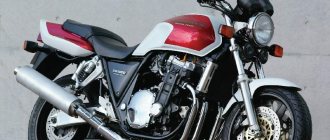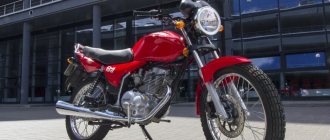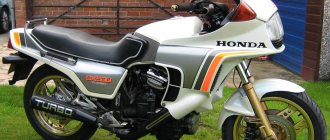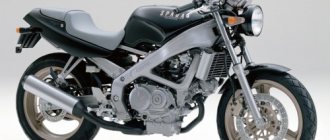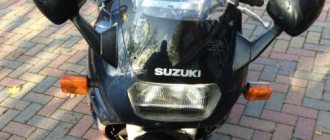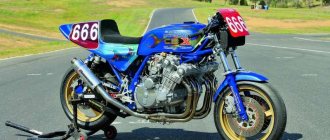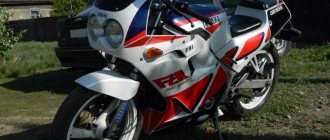| Engine and transmission | |
| Volume | 8200.00 ccm (500.36 cubic inches) |
| engine's type | V8, four-stroke |
| Power | 502.00 HP (366.4 kW)) |
| Compression | 9.6 |
| Fuel system | Carburettor. Quadrajet 850cfm |
| Cooling system | Liquid |
| Transmission type | Belt |
| Exhaust system | 2.5´ with dual mufflers |
| Chassis, suspension, brakes, wheels | |
| Fork angle | 33.0° |
| Suspension, front | 63mm inverted forks, adj. preload 2.5´ travel |
| Suspension, rear | Dual 13.0´ coilover shocks, adj. preload |
| Tires, front | 130/90-16, 3.50×16.0 |
| Tires, rear | 230/60-7.0×15.0 |
| Dimensions | |
| Weight, dry | 589.7 kg (1,300.0 pounds) |
| Power/weight ratio | 0.8513 HP/kg |
| Seat height | 724 mm (28.5 inches) If adjustable, lowest setting. |
| Width, full | 787 mm (31.0 inches) |
| Clearance | 114 mm (4.5 inches) |
| Wheelbase | 2,083 mm (82.0 inches) |
| Gas tank volume | 32.17 liters (8.50 gallons) |
Call center 24 hours. Any questions from those. consultations to assistance with placing an order.
BOSS HOSS – 8.2 liter motorcycle
700 kg weight (description inside)
No duplicates found
Shortened version of the review from motoviewer
Americans have the biggest everything: the biggest people, the biggest cars, and, for that matter, the biggest motorcycles. Today we will talk about one monster in the world of motorcycles - Boss Hoss. Have you heard of these? Don't be upset if not.
The homeland of these monsters is Texas. Boss Hoss Cycles was founded in 1990 by Monte Warn. It all started with the fact that a 5.7-liter Chevy V-8 engine was mounted into a motorcycle frame! Such engines are installed in SUVs such as the Chevrolet Tahoe and the Chevrolet Camaro muscle car. I think you roughly understand the power and cost of such engines? The motorcycle turned out to be quite unusual. It had only one gear (and you don’t need more, I’ll tell you.) Then the company continued its development and noticeably expanded its range. Parts have been significantly improved (Brembo brake systems, inverted forks, etc.). Although there are officially about two dozen Boss Hoss “models”, which are graded by year and include both motorcycles and trikes, you shouldn’t pay much attention to this. Every, absolutely every, copy of this brand is made to order!
In 2005, Boss Hoss released the BHC-3 502, which was a cruiser with a giant engine. The working volume of the power unit was 8200 cubic meters. see the 4-stroke V-shaped engine of the model had 8 cylinders. The engine was cooled by liquid. The engine operated with a compression ratio of 9.6:1. The model was equipped with a Quadrajet 850cfm carburetor and a powerful exhaust system with two mufflers. The maximum engine power was 502 horsepower. The transmission of torque to the rear wheel was carried out by a belt. The front suspension was represented by an inverted fork, adjustable according to the degree of spring preload. The diameter of its feathers was 63 mm. The rear suspension, adjustable according to the degree of spring preload, had two shock absorbers. The dry weight of the model was 589.7 kg. The height of the motorcycle at the saddle was 724 mm, and the length of the wheelbase was 2083 mm. The front wheel diameter was 16 inches, and the rear wheel diameter was 15 inches. The front tire size was 130/90-16 and the rear tire size was 230/60-15. The overall width of the motorcycle was 787 mm. The ground clearance was 114 mm, and the gas tank volume was 32.17 liters.
The first time I saw this monster was at the Minsk opening of the season. I had heard about these motorcycles before, but I didn’t even expect to see it in person. Boss Hoss easily won the loudest exhaust competition, simply deafening the airfield with its roar. No, not even a roar. More like thunderclaps! Nobody buys it, due to such characteristics as the price ($53 thousand) and, first of all, fuel consumption - 30 liters. per 100 km. And it is far from cheap to maintain.
0:00 – 01:00 – appearance 01:00 – 01:22 acceleration from 60 to 240 01:22 – end – communication with Yamaha R1
Boss Hoss with V6 engine
The idea of putting the biggest engine in the smallest frame, and then riding the result, probably appeared with the first car on Earth. So, I think it won’t surprise you too much if I tell you that a V8 engine was in a motorcycle back in 1906. Glenn Hammond Curtis put on two wheels a motor of his own production, originally designed for airships: Curtiss Model B-8 , with two carburetors and a volume of 4.4 liters, produced as much as 40 horsepower at 1800 rpm.
And this miracle of technology accelerated comrade Curtis to 219 kilometers per hour, after which Glenn held the title of the fastest man on Earth for four years. His record was broken only in 1911. Two facts are noteworthy: before Glenn, the speed record belonged to trains. And after comrade Curtis, a car took the speed record: among motorcyclists, Glenn remained the fastest until 1930. only those who completely lack even a hint of it can accelerate to two hundred kilometers per hour on something similar to a Curtiss V-8 to the instinct of self-preservation.
If you think T-buckets aren't the safest vehicle, just look at the Curtiss V-8. Compared to this motorcycle, any bucket is a standard of safety.
After Glenn Curtis, quite a few people built their own version of a V8 motorcycle, but perhaps Monty Warne . By some coincidence, Warne, like Curtis, is associated with aviation: Monty is a certified aircraft technician and former pilot. Comrade Warne built his first V-8 bike in 1990, mostly out of a desire to test his own abilities. It is not known exactly how further events developed, but already in the same year 1990, Monty had his own team of engineers, and the company they founded, Boss Hoss, acquired its first clients.
One of the Boss Hoss kit bikes. If you are familiar with modern Hoss products, then you can feel the difference and the long journey that the company has come from its beginnings in the 90s.One of the Boss Hoss kit bikes. If you are familiar with modern Hoss products, then you can feel the difference and the long journey that the company has come from its beginnings in the 90s.
One of the Boss Hoss kit bikes. If you are familiar with modern Hoss products, then you can feel the difference and the long journey that the company has come from its beginnings in the 90s.
Today, Boss Hoss has a reputation for producing perhaps the most American bikes, not counting Harley-Davidson. But Boss Hoss began much more modestly: by selling not even the motorcycles themselves, but kits for their construction - the so-called kit bikes. In other words, the buyer got the frame, a single-speed gearbox and many other very useful parts, but the engine and a few other unimportant little things had to be obtained somewhere else. The final result thus largely depended on the directness of the buyer's hands. For these reasons, early Hoss often had a very homemade appearance, and sometimes, even before the first ride, they were overgrown with a set of spare parts intended for Harley-Davidsons and Chevys.
This motorcycle could easily be mistaken for another early Boss Hoss, but in fact it is a Kannon with the same Chevrolet V6 engine that Monty Warne would use in his motorcycles. Unfortunately, Kannons did not withstand the realities of the market and are no longer produced. Information about them is minimal, but this '97 model is excellent for visual comparison with a similar model of the same year from Hoss.This motorcycle could easily be mistaken for another early Boss Hoss, but in fact it is a Kannon with the same Chevrolet V6 engine that Monty Warne would use in his motorcycles. Unfortunately, Kannons did not withstand the realities of the market and are no longer produced. Information about them is minimal, but this '97 model is excellent for visual comparison with a similar model of the same year from Hoss.
This motorcycle could easily be mistaken for another early Boss Hoss, but in fact it is a Kannon with the same Chevrolet V6 engine that Monty Warne would use in his motorcycles. Unfortunately, Kannons did not withstand the realities of the market and are no longer produced. Information about them is minimal, but this '97 model is excellent for visual comparison with a similar model of the same year from Hoss.
This motorcycle could easily be mistaken for another early Boss Hoss, but in fact it is a Kannon with the same Chevrolet V6 engine that Monty Warne would use in his motorcycles. Unfortunately, Kannons did not withstand the realities of the market and are no longer produced. Information about them is minimal, but this '97 model is excellent for visual comparison with a similar model of the same year from Hoss.
This motorcycle could easily be mistaken for another early Boss Hoss, but in fact it is a Kannon with the same Chevrolet V6 engine that Monty Warne would use in his motorcycles. Unfortunately, Kannons did not withstand the realities of the market and are no longer produced. Information about them is minimal, but this '97 model is excellent for visual comparison with a similar model of the same year from Hoss.
This motorcycle could easily be mistaken for another early Boss Hoss, but in fact it is a Kannon with the same Chevrolet V6 engine that Monty Warne would use in his motorcycles. Unfortunately, Kannons did not withstand the realities of the market and are no longer produced. Information about them is minimal, but this '97 model is excellent for visual comparison with a similar model of the same year from Hoss.
This motorcycle could easily be mistaken for another early Boss Hoss, but in fact it is a Kannon with the same Chevrolet V6 engine that Monty Warne would use in his motorcycles. Unfortunately, Kannons did not withstand the realities of the market and are no longer produced. Information about them is minimal, but this '97 model is excellent for visual comparison with a similar model of the same year from Hoss.
This motorcycle could easily be mistaken for another early Boss Hoss, but in fact it is a Kannon with the same Chevrolet V6 engine that Monty Warne would use in his motorcycles. Unfortunately, Kannons did not withstand the realities of the market and are no longer produced. Information about them is minimal, but this '97 model is excellent for visual comparison with a similar model of the same year from Hoss.
This motorcycle could easily be mistaken for another early Boss Hoss, but in fact it is a Kannon with the same Chevrolet V6 engine that Monty Warne would use in his motorcycles. Unfortunately, Kannons did not withstand the realities of the market and are no longer produced. Information about them is minimal, but this '97 model is excellent for visual comparison with a similar model of the same year from Hoss.
This motorcycle could easily be mistaken for another early Boss Hoss, but in fact it is a Kannon with the same Chevrolet V6 engine that Monty Warne would use in his motorcycles. Unfortunately, Kannons did not withstand the realities of the market and are no longer produced. Information about them is minimal, but this '97 model is excellent for visual comparison with a similar model of the same year from Hoss.
This motorcycle could easily be mistaken for another early Boss Hoss, but in fact it is a Kannon with the same Chevrolet V6 engine that Monty Warne would use in his motorcycles. Unfortunately, Kannons did not withstand the realities of the market and are no longer produced. Information about them is minimal, but this '97 model is excellent for visual comparison with a similar model of the same year from Hoss.
This motorcycle could easily be mistaken for another early Boss Hoss, but in fact it is a Kannon with the same Chevrolet V6 engine that Monty Warne would use in his motorcycles. Unfortunately, Kannons did not withstand the realities of the market and are no longer produced. Information about them is minimal, but this '97 model is excellent for visual comparison with a similar model of the same year from Hoss.
This motorcycle could easily be mistaken for another early Boss Hoss, but in fact it is a Kannon with the same Chevrolet V6 engine that Monty Warne would use in his motorcycles. Unfortunately, Kannons did not withstand the realities of the market and are no longer produced. Information about them is minimal, but this '97 model is excellent for visual comparison with a similar model of the same year from Hoss.
However, fans of rat bikes and other very crude-looking machines existed at that time. In addition, a well-built Boss Hoss was, although not the most comfortable, still a full-fledged motorcycle. Those few who used it every day were able to appreciate the difference in vibration between two cylinders and eight, and bikers who had at their disposal not only a Hoss, but also a Harley, often preferred the Boss, at least in winter: the huge engine warmed their legs perfectly . In short, despite all the shortcomings, the number of customers grew steadily, and therefore in 1996 Monty Warne earned enough money to move from kit bikes to the construction of full-fledged motorcycles. This approach allowed us to establish full-fledged quality control, which quickly grew into improvements in design and construction.
See also The Fastest Indian, biography of Bert Monroe
One of the Boss Hoss V6 bikes. Unlike the Kannon motorcycle, which is in many ways similar to the early Boss Hoss, this machine already has a very recognizable design of the second generation of Hoss, custom parts like an exhaust manifold, and also - which is important for the market - its own brand.One of the Boss Hoss V6 bikes. Unlike the Kannon motorcycle, which is in many ways similar to the early Boss Hoss, this machine already has a very recognizable design of the second generation of Hoss, custom parts like an exhaust manifold, and also - which is important for the market - its own brand.
One of the Boss Hoss V6 bikes. Unlike the Kannon motorcycle, which is in many ways similar to the early Boss Hoss, this machine already has a very recognizable design of the second generation of Hoss, custom parts like an exhaust manifold, and also - which is important for the market - its own brand.
The V6 motorcycles Warne produced in '97 and '98 were largely experimental for the Boss Hoss brand. In particular, it was the six-cylinder models that were first equipped with a new two-speed automatic transmission. Plus, especially for the small 4.3-liter Chevrolet engine, the frame was narrowed and shortened. But despite this, the bike remained quite huge compared to other motorcycles.
Some vintage photos from the 1997 article. Note the missing radiator housing: bikers may well have removed it after purchasing the motorcycle, but it is unlikely that Boss Hoss would have provided the bike to journalists in this form. Most likely, the company did not yet have radiator housings in 1997.Some vintage photos from the 1997 article. Note the missing radiator housing: bikers may well have removed it after purchasing the motorcycle, but it is unlikely that Boss Hoss would have provided the bike to journalists in this form. Most likely, the company did not yet have radiator housings in 1997.
One of the articles, written in 1997, plainly says that the first thing you need to do is get used to the size of the bike. But this is the only negative mentioned in the article. The author writes that the new automatic transmission works perfectly, and there is no need to be distracted by gears. The Boss Hoss turns, as expected, reluctantly, but at the same time, the control is “neutral and natural”: with a little practice, even a full turn can be easily performed in one movement. It’s comfortable to sit on the motorcycle: the seat height is 66 centimeters, and the brake lever is located a little far away. On the other hand, reaching for it doesn’t make much sense: the bike’s rear brakes are much more practical.
Despite the fact that the photographs of the motorcycle are dated 2008, the advertisement for the sale of this bike itself is dated 2019. Let's just hope that this Boss Hoss actually managed to survive 10 years and remain in such good condition that the seller simply didn't see the point in taking new photos.Despite the fact that the photographs of the motorcycle are dated 2008, the advertisement for the sale of this bike itself is dated 2019. Let's just hope that this Boss Hoss actually managed to survive 10 years and remain in such good condition that the seller simply didn't see the point in taking new photos.
Despite the fact that the photographs of the motorcycle are dated 2008, the advertisement for the sale of this bike itself is dated 2019. Let's just hope that this Boss Hoss actually managed to survive 10 years and remain in such good condition that the seller simply didn't see the point in taking new photos.
Despite the fact that the photographs of the motorcycle are dated 2008, the advertisement for the sale of this bike itself is dated 2019. Let's just hope that this Boss Hoss actually managed to survive 10 years and remain in such good condition that the seller simply didn't see the point in taking new photos.
And, as the author notes, more than 150 horsepower on two wheels allows the motorcycle to reach very serious speeds. Sure, sportbikes will still be faster, but none of them can offer the feeling that the Boss Hoss offers as it relentlessly accelerates its mass of hardware. With a fuel consumption of 8 liters per hundred kilometers and a gas tank of just over 28 liters, it turns out to be quite a decent cruiser. The author does not advise ladies to wear a skirt if they want to ride such a motorcycle: the solid shape of the bike forces the rider to spread his legs very wide.
See also The Loveless, a biker movie with Willem Dafoe
The owner of this six-cylinder motorcycle took the time to take a lot of pictures showing the mechanisms and small parts of the bike. So despite the poor quality of the photos, it was this ad that gave me the opportunity to look at the Boss Hoss and Chevy's V6 in great detail.The owner of this six-cylinder motorcycle took the time to take a lot of pictures showing the mechanisms and small parts of the bike. So despite the poor quality of the photos, it was this ad that gave me the opportunity to look at the Boss Hoss and Chevy's V6 in great detail.
The owner of this six-cylinder motorcycle took the time to take a lot of pictures showing the mechanisms and small parts of the bike. So despite the poor quality of the photos, it was this ad that gave me the opportunity to look at the Boss Hoss and Chevy's V6 in great detail.
The owner of this six-cylinder motorcycle took the time to take a lot of pictures showing the mechanisms and small parts of the bike. So despite the poor quality of the photos, it was this ad that gave me the opportunity to look at the Boss Hoss and Chevy's V6 in great detail.
The owner of this six-cylinder motorcycle took the time to take a lot of pictures showing the mechanisms and small parts of the bike. So despite the poor quality of the photos, it was this ad that gave me the opportunity to look at the Boss Hoss and Chevy's V6 in great detail.
The owner of this six-cylinder motorcycle took the time to take a lot of pictures showing the mechanisms and small parts of the bike. So despite the poor quality of the photos, it was this ad that gave me the opportunity to look at the Boss Hoss and Chevy's V6 in great detail.
The owner of this six-cylinder motorcycle took the time to take a lot of pictures showing the mechanisms and small parts of the bike. So despite the poor quality of the photos, it was this ad that gave me the opportunity to look at the Boss Hoss and Chevy's V6 in great detail.
The owner of this six-cylinder motorcycle took the time to take a lot of pictures showing the mechanisms and small parts of the bike. So despite the poor quality of the photos, it was this ad that gave me the opportunity to look at the Boss Hoss and Chevy's V6 in great detail.
The owner of this six-cylinder motorcycle took the time to take a lot of pictures showing the mechanisms and small parts of the bike. So despite the poor quality of the photos, it was this ad that gave me the opportunity to look at the Boss Hoss and Chevy's V6 in great detail.
The owner of this six-cylinder motorcycle took the time to take a lot of pictures showing the mechanisms and small parts of the bike. So despite the poor quality of the photos, it was this ad that gave me the opportunity to look at the Boss Hoss and Chevy's V6 in great detail.
The owner of this six-cylinder motorcycle took the time to take a lot of pictures showing the mechanisms and small parts of the bike. So despite the poor quality of the photos, it was this ad that gave me the opportunity to look at the Boss Hoss and Chevy's V6 in great detail.
The owner of this six-cylinder motorcycle took the time to take a lot of pictures showing the mechanisms and small parts of the bike. So despite the poor quality of the photos, it was this ad that gave me the opportunity to look at the Boss Hoss and Chevy's V6 in great detail.
The owner of this six-cylinder motorcycle took the time to take a lot of pictures showing the mechanisms and small parts of the bike. So despite the poor quality of the photos, it was this ad that gave me the opportunity to look at the Boss Hoss and Chevy's V6 in great detail.
The owner of this six-cylinder motorcycle took the time to take a lot of pictures showing the mechanisms and small parts of the bike. So despite the poor quality of the photos, it was this ad that gave me the opportunity to look at the Boss Hoss and Chevy's V6 in great detail.
The owner of this six-cylinder motorcycle took the time to take a lot of pictures showing the mechanisms and small parts of the bike. So despite the poor quality of the photos, it was this ad that gave me the opportunity to look at the Boss Hoss and Chevy's V6 in great detail.
The owner of this six-cylinder motorcycle took the time to take a lot of pictures showing the mechanisms and small parts of the bike. So despite the poor quality of the photos, it was this ad that gave me the opportunity to look at the Boss Hoss and Chevy's V6 in great detail.
The owner of this six-cylinder motorcycle took the time to take a lot of pictures showing the mechanisms and small parts of the bike. So despite the poor quality of the photos, it was this ad that gave me the opportunity to look at the Boss Hoss and Chevy's V6 in great detail.
The owner of this six-cylinder motorcycle took the time to take a lot of pictures showing the mechanisms and small parts of the bike. So despite the poor quality of the photos, it was this ad that gave me the opportunity to look at the Boss Hoss and Chevy's V6 in great detail.
The owner of this six-cylinder motorcycle took the time to take a lot of pictures showing the mechanisms and small parts of the bike. So despite the poor quality of the photos, it was this ad that gave me the opportunity to look at the Boss Hoss and Chevy's V6 in great detail.
History remains silent as to why the V6-powered Boss Hoss was only produced for a few years. Perhaps the journalists were not too honest and the bike still had problems. Or maybe Monty Warne simply didn’t have enough budget to promote three engines to the people at once. And it’s quite possible that the V6 simply wasn’t popular enough: when you can buy a motorcycle with a much more familiar and popular V8 for almost the same price, it’s quite logical that people would choose the eight-cylinder version.
Unfortunately, there is only one photo of this motorcycle. I found it on a forum for owners of motorcycles with a V-twin engine, and attempts to contact the owner of this bike yielded nothing.
In general, all V6 Hoss that have survived to this day can already be called rarities: motorcycles have been on the road for more than twenty years. And each of them is one of the few six-cylinder bikes that can be called production. I would say that these motorcycles are another small achievement of the American school of mechanical engineering.
Sources
https://www.drummerdonnie .com/BossHoss.html https://www.kloompy. com/motorcycles/1998-boss-hoss-bh3_i425 https://www.bikewale. com/news/30546-cult-bike-of-the-day-boss-hoss-cycles.html https://www.motorcyclenews .com/news/2016/march/mcn-plus—boss-hoss-v6-first -ride—bike/ https://suprememotos. com/boss_hoss/80420-1998-boss-hoss-limited-edition-american-v6-motorcycle-mint-condition.html https://www.2040-motos.com/Boss-Hoss/Boss-Hoss/1998-boss -hoss-v6-clean-282/ https://newatlas .com/glen-curtiss-pioneer-aviator-land-speed-record-holder/46766/ https://www.cycletrader .com/listing/1997-Kannon -V6-5011207035
ChevroletMotorcycle
5 / 5 ( 1 voice )
(Visited 375 times, 1 visits today)
Roma-Urraco › Blog › Cezeta 502: the most desirable scooter in the USSR
Motor scooters were a very popular vehicle in the Soviet years, but their range was not particularly diverse. The Tula Motor Plant offered consumers its “Tula”, “Tourists”, “Tulitsa” and “Ants”, and the Vyatsko-Polyansky machine builders gave the country “Vyatka” and “Electrons”. Only in the first half of the 60s were Czechoslovakian Cezeta motor scooters officially supplied to the USSR, which immediately received the popular nickname “pig” for their characteristic appearance.
The production of compact Chesets was carried out by the company CZ Strakonice AS, which in the post-war years became part of the Jawa association. The design of these unusual machines was created by engineer Jaroslav Koch, who at one time became famous as the creator of the pre-war Praga motorcycles. However, back in 1940, he not only developed, but also patented a motor scooter of an original design with a monocoque body.
Over the following years, Yaroslav Koch continued to work on the creation of scooters, and in 1957, the first production samples were finally released - 300 copies of the Cezeta 501 model.
The device with a monocoque body was longer than its analogues, its front part of the body resembled a torpedo, and under the forward headlight there was something resembling a bumper. The fuel tank is located in the upper part of the body along with the headlight, resulting in ample space under the driver's seat for storing luggage and tools. The Cezeta scooter was equipped with a tubular motorcycle handlebar, a kickstarter and a 1-cylinder 2-stroke engine with a power of 8 hp. s., similar to the engine of a light motorcycle CZ-175.
The Cezeta 501 was equipped with a round speedometer and rather large 12-inch wheels, which was not very typical for scooters. By the way, the power unit is also placed not like a scooter - on a swinging suspension arm, but like a motorcycle - on the supporting structure of the device. A year later, a trunk was installed above the gas tank, and the ignition switch was moved to the top of the dashboard closer to the speedometer.
Thanks to the large wheels, the Czechoslovakian scooter was stable and had good maneuverability, and it was also possible to use Cezet motorcycle parts for it, which simplified maintenance. The Cezeta 501 scooter was repeatedly modernized, and all subsequent modifications had their digital designation added to “501”.
The new model Cezeta 501/01 featured a rather imperfect air cooling system, while other European analogues already used a forced cooling system. The designers took this into account, and the third generation of the Cezeta 501/03 scooter was equipped with a fan, as well as hydraulic shock absorbers and 12-volt electrical equipment. A dynamo starter and a lever suspension for the rear wheel were installed on the Cezeta 501/05 scooter.
In the 60s, “Cheseta” began to be exported to 20 countries, including the USSR, where it competed with the domestic “Vyatka” and “Tula”. The appearance of a 172 cc scooter against the backdrop of the Vyatka with an engine capacity of 150 cc, and the Tula with an engine capacity of 200 cc played a role in the fact that specialists in the domestic motorcycle industry did not develop their own scooters of a similar capacity. In total, the Czech plant CZ produced 43 thousand Cezeta 501 scooters.
The plant's designers continued to work on increasing the power of scooters, which also required changes to the chassis. Thus, in December 1960, a new 172 cc scooter, Cezeta 502, appeared. The engine power of the new model was increased to 9.5 hp, the cooling system was improved and thermal stress was balanced, which made it possible to avoid overheating of the engine on the rise.
The Cezeta 502 scooter, accelerating up to 90 km/h, was equipped with turn signals, light signaling and a redesigned muffler, and the sound signal was moved from the windshield under the body. The Cezeta 502 scooters were two-tone and offered in six color combinations. Like the Cezeta 501 scooter, the Cezeta 502 model also had its own modifications, among which the most notable were 502/05 and 502/06 - Cezeta DeLuxe. These scooters had a rather stylish appearance thanks to a shaped cast steering wheel with an oval speedometer built into it in the style of Jawa. Over the entire existence of the Cezeta 502 scooter, 72 thousand units were produced.
The Boss Hoss ZZ4 350 is a true two-wheeled beast, powered by a V-8 engine. Produced in small batches for more than a decade in several variations, even among small-scale bikes it is the largest in terms of engine capacity. It's no joke - the V-8 engine installed on this motorcycle, which one hardly dares to call a chopper, is installed on such monsters of the American automobile industry as the Chevrolet Tahoe and Chevrolet Camaro.
The Boss Hoss ZZ4 is available in various modifications, differing in weight, engine characteristics, drive type and other important points that are not obvious at first glance. The most common, “basic” version of this motorcycle is a 355-horsepower V-8 engine producing more than 400 nm of torque, with a belt drive and a two-speed automatic transmission (plus reverse gear, of course). However, there is also a modification with 502 hp. and more than 600 torque, but now we are still talking about the Boss Hoss ZZ4 350. The weight of this chrome-plated two-wheeled monster is 502 kilograms. Long, wide and squat, the Boss Hoss ZZ4 350 is raw, brazen, and raw power. The huge and shamelessly bulging engine hints to everyone around who is the real king of the road here, and when you sharply open the throttle, even while driving, a loud roar is heard, accompanied by the rear wheel slipping on the asphalt and smoking tires.
It goes without saying that you need to be above average height, considerable physical strength and considerable experience to control such a monster as the Boss Hoss ZZ4. A person below average height simply will not reach the steering wheel by turning it, and it will be difficult to reach the ground due to the height of the motorcycle and its wide seat, and this, given the weight of the bike, can be critical.
However, for all its monstrousness, the Boss Hoss ZZ4 was created not only “for show-offs,” although, of course, it was primarily for them. American bikers consider this motorcycle to be very reliable, and there are many people who successfully travel on this rocket. A gas tank with a volume of 32 liters provides the Boss Hoss ZZ4 with a power reserve of more than 200 kilometers, and the fuel consumption sensor will not allow the more or less attentive rider to remain somewhere on the side of the road with a dry tank without a drop of fuel in it. The Boss Hoss ZZ4 is actually very comfortable to sit on, provided your build allows it at all. Well, it’s probably not worth mentioning how much adrenaline this motorcycle can give.
The designers also took care of the brakes. The dual-disc front and single-disc rear brakes stop half a ton of chrome iron surprisingly effectively. Well, as soon as the traffic light turns green, the Boss Hoss ZZ4 is again capable of rushing so hard that it will leave behind everyone who dares to compete with it. Of course, on city streets with dense traffic, the Boss Hoss does not feel very confident due to its enormous size and large mass, but climbing between rows in traffic jams on such a motorcycle is unlikely to occur to anyone, right? Such equipment is purchased not for everyday trips to work, but for the soul.
Similar articles:
- Kawasaki VN 400 Vulcan
- 2010 Harley-Davidson Road Glide Review
- Yamaha FZ-1 Review
- Honda Magna 250 review
- Big choppers
- Review of Kawasaki VN 2000 Vulcan
LiveJournal

